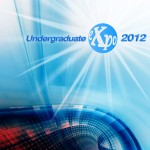 More than 50 Senior Design and two dozen Enterprise teams converged on the Memorial Union Thursday, and their projects were as impressive as they were varied.
More than 50 Senior Design and two dozen Enterprise teams converged on the Memorial Union Thursday, and their projects were as impressive as they were varied.
The Union filled up early as crowds, judges, media and local school children checked out the inventive creativity on display.
Photos at the www.expo.mtu.edu website
Senior Design Taking first place was Bioabsorbable Polymer-Coated Metal Stent Degradation Simulation Design. The students devised a better way to check for the degrading of stents, which are inserted into arteries, both in vitro (in the lab) and in vivo (in the living subject). Team members were Kristina Price, Brendan Daun, Thomas Faulkner, Erin Larson, Derek Yesmunt and David Strobel (Biomedical Engineering); and Kelsey Waugh and Matt Gardeski (MSE). The team was sponsored by Boston Scientific and advised by Associate Professor Jeremy Goldman (Biomedical Engineering) and Associate Professor Jaroslaw Drelich (MSE).
Second place went to the Economic Recovery of Alloying Elements from Grinding Swarf. The students speculated that they could help metal-grinding operations reclaim cobalt and nickel, in addition to other metals, from the waste or “swarf.” It could produce as much as $1.75 million in a year. The team consisted of Alicia Steele (MSE/ME); and Daniel Hein, Michael Wyzlic and Nicholas Kraft (MSE). They worked with the Casting Services Group of ThyssenKrupp. Jaroslaw Drelich was their advisor, too.
Third place was Portage Health Noise Monitoring Device, an ingenious invention to warn of unacceptable noise levels in a hospital setting. The team was J. Ethan Lynch, Shaubhik Bhattacharjee, Trent Jansen and J. Nathan Willemstein (Biomedical Engineering); and Lynn Giesler (Biomedical Engineering/ME). Advisors were Professor Michael Neuman (Biomedical Engineering) and Associate Professor Keat Ghee Ong (Biomedical Engineering).
Enterprise First place went to IT Oxygen, with team leader Garrett Lord (Computer Engineering/CNSA) and advisor Bob Maatta, professor of practice in the School of Technology.
Second place was Blizzard Baja, with team leaders Joseph DeHaan, Andrew Glaeser, Brett Schulte and Matt Rebandt (ME). Their advisor was Senior Lecturer Brett Hamlin (Engineering Fundamentals).
Finally, Aqua Terra Tech won third place, with team leaders Zach Guerrero (Environmental Engineering) and Neil Baltes (GMES). Advisor was Professor John Gierke (GMES).
Patents and Future Innovators In a new twist, teams were invited to apply for patents, and a couple of awards were given out.
The Best Technical Specification Award went to Magnetically Damped Suspended Isolation System, submitted by ME majors Oskar Strojny, Jake Simula and Brian Turner.
The Best Prior Art Review and Competitive Analysis Award went to Scanning Tunneling Microscope Tip Actuator System, submitted by Ryan James, Kyle Smith, Scott Schmitt, Patrick McGraw and Lee Anderson (EE) and Chris Cerovec (Computer Engineering).
Organizers of the event were especially excited about the patent competition and look forward to growing this new component of the Expo in the future.
The school children also had a hand in awards. The Future Innovator Awards, voted on by Hancock and Chassell middle-school students, went to the Pet-Friendly Motorcycle Sidecar Senior Design team with members Brad Lynn, Joseph Supinsky and Jan Zlebek (MET), advised by Associate Professor John Irwin (SOT); and Robotic Systems Enterprise team with leaders Colin Putters (School of Business and Economics) and Megan Crowley (SFRES), advised by Assistant Professor Aleksandr Sergeyev (SOT).